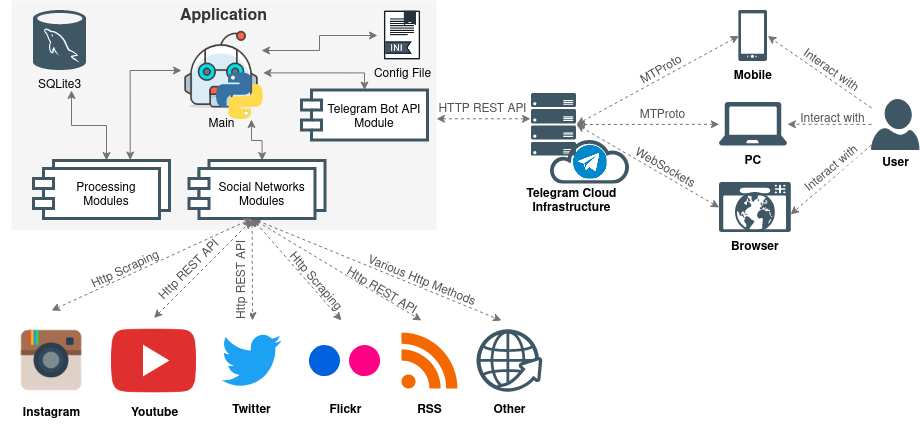- Project's Repo: gitlab.com/meliurwen/feedgram
- Project's Documentation: meliurwen.gitlab.io/feedgram/
- Demo Link: t.me/FeedGram_demo_bot
Note: At the moment it's in pre-alpha state; a sensible part of our available resources has been invested on the study on learning agile practices.
A simple to use, but yet powerful Telegram bot app living in the cloud with advanced functionalities! ☁️💪
This multi-user bot allows to receive news, RSS feeds, social networks and other platforms posts into a single and curated inbox!
The first platforms supported will be the most popular ones: Instagram, Youtube, Flickr, Twitter, Artstation, etc...
The diagram below is the high level architecture of this project and describes the interactions between the internal components of the app and between the app and the external ones:
As described by the diagram the bot does not interact directly with the users, but it accomplish this via the Telegram's stack using APIs expressively provided for the bots.
The interactions with the socials/platforms will be done with various methods and techniques that depends on how (and at which conditions) each social/platform we interact with exposes the data we need. In most cases is better use the official APIs provided via HTTP methods (GET or POST) or OAuth, but in few cases for various reasons the classic scraping methods are more convenient.
The internal structure of the application is mainly composed by a multitude of specialised python modules, an SQLite3 database and a config file in ini format, most of them directly orchestrated by a main module.
You can find the documentation on GitLab Pages here, or at this link:
At the moment platforms officially supported are:
- Docker
- Debian 10
- Ubuntu 18.04
- Python Wheels
Go to the releases section to download the latest installer:
Prerequisites:
docker
Launch:
docker run -d --name feedgram --restart unless-stopped \
-v config.ini:/app/config.ini \
-v socialFeedgram.sqlite3:/app/socialFeedgram.sqlite3 \
registry.gitlab.com/meliurwen/feedgram:latestPrerequisites:
python3(>=3.6)python3-setuptoolspython3-pip
Install:
At the root of the project's folder launch:
pip3 install .Uninstall:
Anywhere in the system launch:
pip3 uninstall <package_name>Upgrade:
At the root of the project's folder launch:
pip3 install --upgrade .Main Contributors: Meliurwen, Ivan Donati
In this project we use Gitlab's kanban, git, CI/CD infrastructure and registry.
See CONTRIBUTING.md to know how to report bugs, propose features, merge requests or other forms of contribution! 😎🚀
Prerequisites:
python3(>=3.6)python3-setuptoolspython3-pippython3-venv(optional)
Create the virtual environment in the project's folder:
python3 -m venv venvOr if oyu wanna use the virtualenv package:
virtualenv -p python3 venvActivate the virtual environment:
source venv/bin/activatePrepare the development environment:
./setup.py developThat's all! ☕️
Tip: To deactivate the virtual environment simply issue the
deactivatecommand.
Activate the virtual environment as described in Develop. (optional)
Install the dependencies:
pip3 install -r test-requirements.txtTo launch Pytest:
pytestTo launch Pylint:
pylint --output-format=text --rcfile=setup.cfg app/ test/ *.pyTo launch Flake8:
flake8

